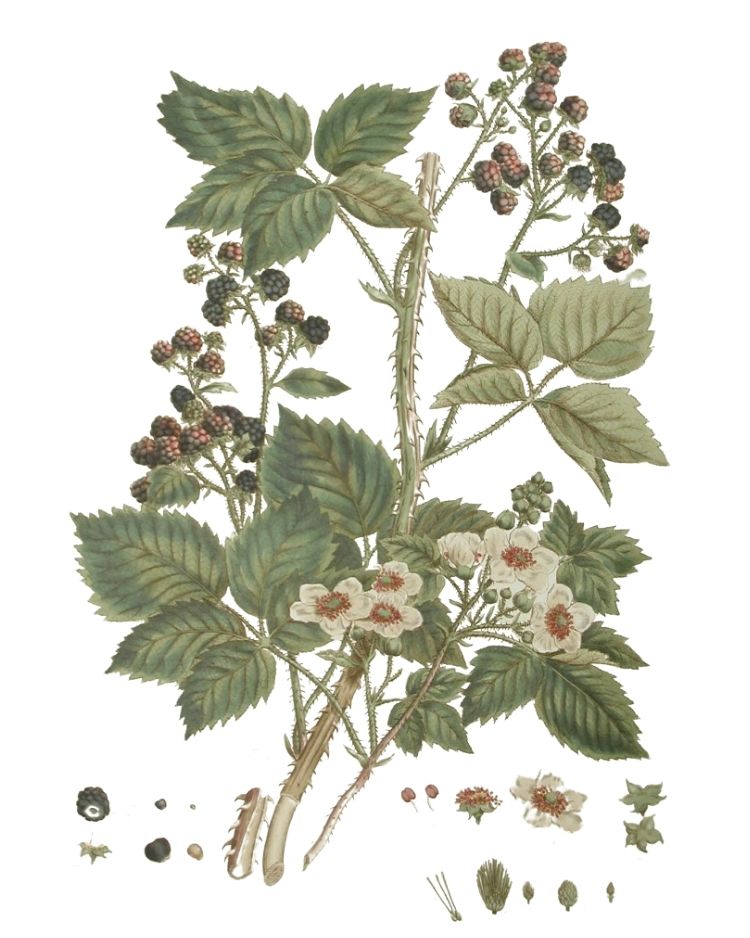A popular bramble fruit, blackberries are often picked in late summer to autumn to make jams, jellies and pies.
Bramble is one of our most commonly used wild edibles and such a familiar hedgerow plant in Britain that it needs no introduction.
The thorny bush often goes overlooked and underappreciated until it starts to produce its fruit.
Traditionally, blackberry picking was a popular late summer activity for many people in Britain, Ireland and other European countries.
In the West Country of England, blackberries are called ‘moochers’, referring to ‘mooching’ or ‘playing truant’, when children are late for school.
The thorny bramble has always been the friend of poor people because of the wool it collects from sheep. Country women made the wool into mops to sell for a few pence.
The name bramble derives from ‘brambel’ or ‘brymbyl’, meaning prickly. While ‘fruticosus’ comes from the Latin for ‘shrubby’.
Scientific name
Rubus fruticosus agg.
Family
Rosaceae.
Botanical description
Trailing, tangled, thorny stems bearing five-petalled flowers of varying size and colour, with prickly and toothed green leaves that turn reddish-purple in autumn. The fruits turn from green to red to deep-purple black.
Photo identification
Status
Native to Britain and Ireland.
Habitat and distribution
Commonly found in hedgerows, roadsides and waysides across Britain and Ireland. According to Mrs Grieve’s A Modern Herbal: “In Australia, the blackberry grows more luxuriantly than in any other part of the world, though it is common everywhere.”
Entymology
Parts used for food
Stems, shoots, leaves and fruits.
Harvest time
Stems/shoots/leaves: Spring
Fruits: August to October
Food uses
Blackberry picking is a popular pastime in the autumn in Britain and Ireland. Many people in towns and villages will walk along waysides and hedgerows to fill their buckets with blackberries to eat, cook and freeze. However, this is not a modern pastime.
Blackberries have been eaten since early human history. The seeds were found in the stomach of a Neolithic man dug up in Walton-on-the-Naze, Essex. They have also been eaten almost worldwide, for example, the berries are gathered and eaten in China.
Today the fruit is one of the most widely collected wild edibles. Blackberries are used to make jam, jellies, wine, liqueurs and pie fillings.
Blackberries are also mixed with crab apples to make fruit cheeses or can be made into savoury-sweet condiments, such as pickles, chutneys and ketchup, and to flavour vinegar.
In seventeenth-century England, blackberry was drunk as a cordial with spices and brandy. The leaves are used for tea. The stems are steamed and used as a vegetable. The young purple shoots can be added to omelettes or eaten with olive oil and lemon juice, or even with fish eggs.
Blackberry blossom is a useful source of nectar for bees too. Honeybees forage on the flowers to produce light-flavoured, fruity honey.
How to harvest bramble stems
Nutritional profile
Some varieties of blackberries have more dietary fibre than wholemeal bread. Blackberries are also a very good source of vitamin C, around 15mg per 100g. Blackberries contain about 5% sugar.
The first berries that ripen are said to be the sweetest and juiciest, whereas smaller berries further up the stalk that ripen later maybe ‘seedy’.
Recipes
Herbal medicine uses
Herbalists have recommended blackberry jelly, cordial or wine for its potent restorative powers. While Culpeper, who himself needs no introduction, praised the plant as a remedy for almost all ailments from wounds and ulcers to fevers and itching.
In Irish folk medicine, bramble leaves, roots and fruits were a common remedy for ailments such as colds, coughs and flu, because of the plant’s astringent and antiseptic properties.
Bramble was also used to treat sore feet, cuts, burns, ulcers, kidney problems and diarrhoea. There were various remedies from mixing bramble juice with butter to treat swellings and blackberry vinegar to treat fevers, colds, gout and arthritis.
Other uses
In other uses, bramble stems have been used for weaving baskets, thatches, and even beehives, and the roots yield a black dye, as well as being used in the production of an orange dye and a green dye for wool in Scotland and Ireland.
In Devon, bramble shoots were used as fishing rods to pull young rabbits out of burrows. Thorny bramble bushes also provide useful impenetrable barriers alongside country fields.
Safety note
There are few concerns about using bramble in food and medicine, but always consult your doctor for advice if you have a specific condition.
Links
- Edible and medicinal wild plants of Britain and Ireland
- Forage in spring
- Forage in summer
- Forage in autumn
References
Allen, D. E. & Hatfield, G. (2004) Medicinal plants in folk tradition: an ethnobotany of Britain & Ireland. Portland: Timber Press.
Culpeper, N. (1995) Culpeper’s complete herbal: a book of natural remedies for ancient ills. Wordsworth reference. Ware: Wordsworth Editions.
Facciola, S. (1998) Cornucopia II: a source book of edible plants. Vista, CA: Kampong Publications.
Grieve, M. M. (1998) A modern herbal. London: Tiger Books International.
Mabey, R. & Blamey, M. (1974) Food for free. London: Collins.
Mac Coitir, N. & Langrishe, G. (2015) Ireland’s wild plants: myths, legends and folklore.
Sturtevant, E. L. (1919) Sturtevant’s notes on edible plants. Albany: J. B. Lyon.
Vaughan, J. G. et al. (2009) The new Oxford book of food plants. Oxford: Oxford University Press.
Watts, D. (2007) Dictionary of plant lore. Amsterdam?; Boston: Elsevier/AP.
Wyse Jackson, P. (2013) Ireland’s generous nature: the past and present uses of wild plants in Ireland. St. Louis: Missouri Botanical Garden Press.
